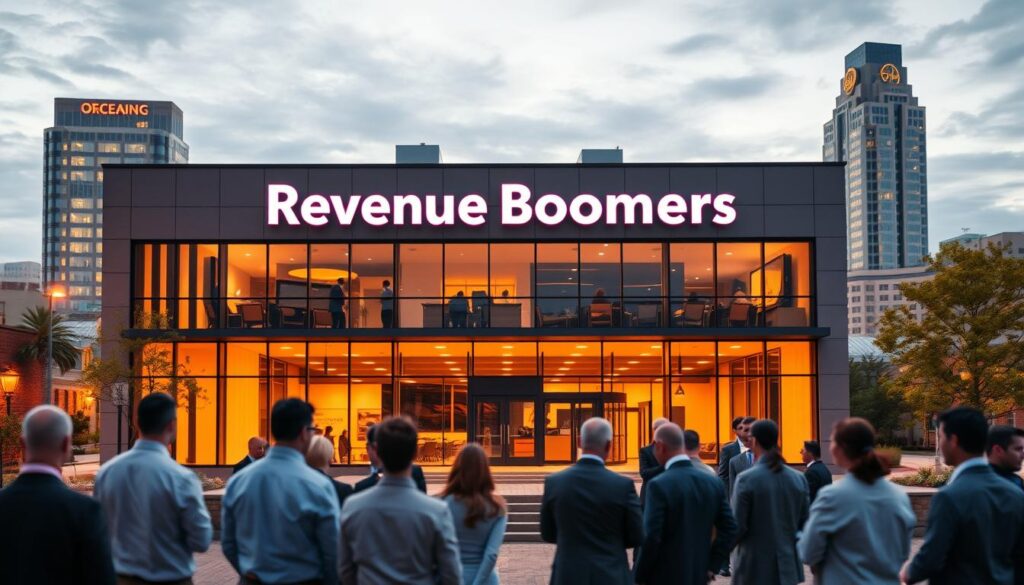With over 5.3 billion people online, it’s key to know how to stand out. SEO strategies are vital for boosting your online presence. As online marketing is set to hit $100 billion by 2026, it’s clear that SEO is essential.
SEO strategies help your content match search engine algorithms and what users want. Companies like Revenue Boomers offer expert advice on these strategies. They help businesses meet their unique needs. Let’s explore how these strategies can elevate your marketing.
Key Takeaways
- SEO strategies are fundamental for enhancing online visibility.
- Effective SEO marketing strategies can lead to a significant increase in organic traffic.
- Adopting long-tail keywords may provide less competition and easier ranking opportunities.
- Building strong backlinks is critical for achieving top search engine rankings.
- Integrating SEO into marketing plans shows positive outcomes—82% of marketers agree.
Understanding SEO Strategies
Digital marketing has made SEO strategies key for online businesses to get noticed. A good SEO plan includes creating, optimizing, and promoting content. It aims to make a website more visible on search engines like Google, which has 91% of the market.
SEO experts work on three main areas: on-page, off-page, and technical SEO. These help websites get more organic traffic and rank better on search engine results. With Google focusing on mobile-first indexing, making mobile versions of websites is crucial.
Neil Patel says using smart SEO strategies can really expand a website’s reach. With over 850 million results for terms like “marketing software for small business,” the competition is tough. Yet, with a 13% increase in digital marketing budgets, investing in SEO is worth it.
As search technology improves, so must our SEO tactics. Improving site speed and using schema markup can help a website’s ranking. These technical aspects are key to boosting a site’s authority.
In 2024, almost all online traffic comes from search engines. Marketers must understand SEO to improve their online presence. Good SEO strategies attract more visitors and boost business performance, leading to more traffic, leads, sales, and authority.
What Are SEO Strategies In Marketing?
Knowing what are SEO strategies in marketing is key for businesses wanting to be seen online. Good SEO strategies do more than pick keywords. They focus on making websites easy to use, work well on mobiles, and have great content. This approach helps websites rank better and keeps users happy.
Most users don’t look past the first page of search results. This shows how vital it is to be at the top to get more visitors and sales. Fast websites are important, as 83% of users want them to load quickly. Quick websites keep users coming back and help with SEO.
Today, websites need to work well on all devices. Using long-tail keywords can help rank better because they’re less competitive. Posting regularly keeps users interested and builds a website’s authority.
| SEO Strategies | Benefits |
|---|---|
| User Experience Optimization | Increased engagement and lower bounce rates |
| Mobile Optimization | Enhanced accessibility for mobile users |
| Regular Content Updates | Improved domain authority and audience retention |
| Use of Long-Tail Keywords | Higher chances of ranking due to lower competition |
| Incorporation of Visual Content | Greater user engagement and retention |
| Building Quality Backlinks | Boosted credibility and improved SEO rankings |
Adding keywords to URLs makes websites easier to find. A full SEO strategy helps businesses not just get more visitors but also keep them coming back.
The Importance of SEO in Digital Marketing
The importance of SEO in digital marketing is huge. With over 5.3 billion people online, good SEO makes a brand more visible. Websites get a lot of traffic from SEO, showing its key role in marketing today.
Users mostly look at the top 10 Google results. This means getting high rankings is crucial to reach customers.
Good SEO strategies bring more organic traffic. This means more people see your site because of its quality. Getting links from trusted sites also boosts your site’s ranking.
Studies show 40.7% of SEO experts believe content marketing is best for getting these links.
Higher rankings also make your brand more trustworthy. This helps attract more customers. SEO helps your business grow over time by bringing in quality visitors.
But, it’s not just about traffic. A great user experience is key. It improves SEO and keeps customers coming back, boosting sales and leads.
SEO is also a cost-effective way to build brand awareness. It takes time, but the benefits last, helping your business grow and stay visible online.
For more on SEO’s role in digital marketing, check out this resource.
Types of SEO Strategies
Knowing the different SEO strategies is key for boosting your online presence. These strategies fall into three main categories: on-page, off-page, and technical SEO. Each type has its own role in making your website more visible and effective.
On-page SEO deals with optimizing your website’s content. It includes:
- Title tags: Keep them under 60 characters, with main and secondary keywords and your brand name.
- Meta descriptions: They should be 160 characters or less, with relevant keywords to draw clicks.
- Content: Use high-quality, original content with keywords, header tags, and variations to boost visibility.
- Internal linking: It helps search engines understand your site’s structure and keeps visitors engaged.
- Image optimization: Optimize image titles, file names, and alt text for better readability and keyword inclusion.
- URL structure: Use dashes to separate keywords in user-friendly URLs, avoiding numbers or dates.
Off-page SEO focuses on activities outside your website, like building backlinks and getting online reviews. It’s crucial for increasing your site’s authority and trustworthiness. Local SEO is a special type that aims to improve local search visibility, using local tactics.
Technical SEO works on the website’s backend to ensure it’s easy for search engines to crawl and index. Key areas include:
- Site architecture: A logical structure makes it easier for users and search engines to navigate.
- Crawling and indexing: It’s essential for search engines to effectively crawl and index your site.
- Page speed: Fast-loading pages improve user experience and help with rankings.
- Mobile-friendliness: With most users accessing websites on mobile, ensuring mobile performance is vital.
- Sitemap: A sitemap helps search engines understand your site’s structure and prioritize indexing.
Using these SEO strategies helps marketers create a solid SEO plan. Understanding these areas leads to a well-rounded approach. This approach supports long-term growth and visibility in the digital world.
Effective SEO Strategies to Boost Visibility
Using effective SEO strategies is key to getting noticed online. One important part is backlink acquisition. Getting links from trusted sites can really help your ranking. Search engines love links from sites with high authority.
Don’t overlook mobile optimization. Sites that work well on mobiles rank better. Since most searches happen on mobiles, making your site mobile-friendly is a must.
Local SEO is vital for businesses with a physical spot. To draw in local visitors, use local keywords and keep your NAP (Name, Address, Phone Number) the same everywhere. This helps you reach the right people.
Website speed matters a lot. Fast sites keep visitors happy and rank better. A one-second load time can triple your conversions compared to a five-second load time.
Keep an eye on your site’s performance with tools like Google Analytics. This lets you see how users behave and what they like. It helps you tweak your SEO for better results.
Using social media signals is smart too. Share your content on social platforms to get more eyes on your site. When people share your stuff, it spreads your message further.
Structured data markup, like schema markup, helps search engines understand your site better. This can make your site more visible in search results. It brings in more visitors by making your content easy to find.
Finally, always be checking your site’s performance with tools like SEMrush and Google Analytics. Keep up with trends and see what your competitors are doing. This helps you stay ahead in the SEO game.
Key Components of a Successful SEO Strategy
For brands wanting to boost their online presence, it’s crucial to focus on the key components of SEO strategy. A key step is to do thorough keyword research. This helps find the right terms and phrases to increase visibility in search engines. Using tools like Google’s Keyword Planner helps avoid choosing the wrong keywords, making sure the strategy follows best SEO practices.
Keywords are important, but quality content is even more crucial. Creating valuable and easy-to-understand content meets audience needs and follows search engine rules. Using too many keywords can harm a site’s ranking.
- On-Page Optimizations: Internal linking, URL structure, and meta tags are key for search engines to navigate your site.
- Link Building: Getting high-quality links is more important than just getting many. Search engines look at link counts and the authority of linking sites.
- Content Variety: Creating different types of content, like blog posts and white papers, helps with SEO.
- Engagement Metrics: Keeping an eye on how users interact with your site is important. It shows how well your site meets user needs, a key factor for Google.
Regularly checking analytics helps businesses tweak their SEO strategy based on how it’s doing. By being proactive, companies can unlock the full potential of search traffic. For example, BuildFire grew into a seven-figure company by using these strategies, seeing a big increase in organic traffic.

Conducting Keyword Research
Starting your journey in conducting keyword research is key to good SEO. It’s about finding the right keywords that match what users are looking for. This makes sure your content meets their needs.
Using broad keywords can attract lots of people because they’re searched often. But, there’s a lot of competition. Long-tail keywords are more specific and have less competition, but they’re searched less often.
Tools like Google Keyword Planner and SEMrush help you see how often keywords are searched and how competitive they are. They give you insights to find the best keywords for your content. Also, looking at what your competitors do can help you find gaps and create better strategies.
Keeping up with what’s trending is important. Watching hashtags on Twitter and Instagram can show you what’s popular. Google Trends is great for seeing what’s trending in searches, helping you stay current.
Good keyword research does more than just bring people to your site. It helps you find customers when your content meets their needs. A good strategy includes keywords that are relevant, have authority, and are searched often.
To do keyword research well, start by making a list of topics and using related search terms. For more tips and tools, check out this guide on keyword research.
On-Page SEO Techniques for Maximum Impact
On-page SEO is key for making webpages more visible in search engines. It also makes websites easier to use. The base of good SEO optimization is in several techniques that boost a site’s performance.
Here are some important on-page SEO techniques to think about:
- Optimizing for Search Intent: Knowing what users want and matching content to it can increase engagement.
- Title Tags: Keeping title tags under 60 characters makes them clearer and more likely to get clicks.
- Meta Descriptions: Descriptions should be no longer than 155 characters. They sum up content and affect search engine results.
- Strategic Keyword Placement: Using target keywords in headings, content, and meta descriptions makes content more relevant.
- Internal Links: These links help search engines understand site structure and encourage users to explore more, leading to new page discoveries.
- URL Optimization: Short and relevant URLs help search engines understand pages better.
- Responsive Design: A design that works on all devices is crucial, as Google now prioritizes mobile-first indexing.
On-page SEO is vital for attracting visitors, with studies showing 95% of search clicks go to the first page. Sites that load quickly, ideally in under three seconds, have lower bounce rates. This positively affects SEO optimization results.
Optimizing images by reducing file sizes and adding descriptive alt tags improves user experience. It also boosts SEO effectiveness.
Off-Page SEO and Building Backlinks
Off-page SEO is key to a website’s authority and trust in search engines. Building backlinks is a big part of this. These links are like votes of confidence from other websites. They help make your site more visible and improve its ranking.
Metrics like Authority Score from Semrush show how well a site is doing. Sites with high Domain Authority Scores tend to rank better. Other important metrics include Page Authority Score, the number of referring domains, and backlinks. All these help show a site’s trustworthiness.
To get more backlinks, create content that people want to share. Reach out to other websites and use social media. Digital PR, influencer marketing, and guest posting are also good ways to get links. These strategies help build strong relationships that boost your site’s SEO.
- Broken link building: Find broken links on good sites and offer your content as a replacement.
- Unlinked brand mentions: Ask for links when your brand is mentioned in articles or blogs without one.
- Social media engagement: Use platforms like LinkedIn, Facebook, and Instagram to grow your online presence and get more brand mentions.
Backlinks from top sites are more valuable than those from lower-quality ones. Studies link more backlinks to better search rankings. Keeping a good backlink profile is crucial. Adding long content can attract more links, as it’s more likely to be shared.
In short, off-page SEO and building backlinks are vital. They help strengthen your online presence and boost your site’s credibility in the digital world.
Technical SEO Best Practices
Using technical SEO best practices is key to making a website better. It’s about making the site faster, ensuring it works well on mobiles, and having clear URLs. These steps help users and search engines find what they need.
Website security is very important. Since 2014, Google has seen SSL as a ranking factor. This means secure sites rank higher. Without HTTPS, a site might not show up well in searches. Also, a content distribution network (CDN) can make your site load faster by caching content on servers around the world.
Mobile optimization is now crucial with Google’s mobile-first indexing. Websites need to focus on mobile versions first. A slow site can see a big jump in bounce rates, with a 90% increase from one to five seconds.
Structured data helps search engines understand your content better. A good sitemap is also key for search engines to find your pages. Managing redirects well is important, as issues with www and non-www versions can cause duplicate content problems.
Technical SEO also looks at a website’s structure. A well-organized site makes it easier for search engines to index pages. Teams use tools like PageSpeed Insights to check how fast a site loads. These SEO techniques in marketing are essential for a strong online presence.

Measuring the Success of Your SEO Strategies
Measuring SEO success means tracking key metrics. These metrics show how well your SEO works. Organic traffic is a key indicator, showing how many visitors find your site through search results.
Click-through rate (CTR) is another important metric. It shows how many people click on your site after seeing it in search results. The top result gets about 27.6% of clicks, while the second and third get 15.8% and 11.0%, respectively.
Keyword rankings help you see how visible your content is. By tracking your rankings for important keywords, you understand how your content performs. Tools like Google Analytics and Search Console help with this, giving insights into user behavior and trends.
Visitor engagement metrics are also key. Time spent on page and bounce rates tell you if your content meets user needs. Longer time on page means better engagement. New visitors might not convert as well as returning ones, who know your brand.
Your SEO strategies should help achieve your business goals. Keep an eye on organic conversion rates and site speed. Analyzing backlinks and website authority can also boost your online presence. Regular updates and ongoing SEO efforts lead to long-term success in digital marketing.
Common SEO Mistakes to Avoid
In the fast-paced world of digital marketing, avoiding common SEO mistakes is crucial. Many businesses fall into pitfalls that can hinder their SEO marketing strategies and impact their online visibility. Keyword stuffing is a major error, leading to poor readability and search engine penalties.
Neglecting mobile optimization is another challenge. With more people using smartphones, a responsive design is essential. Websites without this optimization risk losing search engine visibility.
Ignoring analytics data can lead to a lack of understanding about website performance. Making data-driven decisions is key for successful SEO marketing strategies. Regularly evaluating metrics is crucial for improvement. Inconsistent URL formatting can confuse search engines, affecting page indexing and ranking.
Thin content is another mistake that can harm SEO efforts. High-quality, informative content is vital for attracting and retaining visitors. Search engines favor relevant and engaging content, and without it, rankings can decline.
Overusing external links can slow down websites, affecting user experience. Poor user experiences can lead to negative reviews and lower rankings. Optimizing images is also important; lack of alt text and oversized images can harm content rankings and traffic.
For more insights on avoiding these pitfalls, check out the detailed guide here. It covers technical SEO issues like duplicate content and under-optimized meta tags, which can hurt website performance.
To optimize your strategy, focus on enhancing page speed. Solutions include compressing images and optimizing HTML code. A well-structured site architecture improves crawlability, helping search engine crawlers index pages effectively.
Addressing these common SEO mistakes will help engage users and improve your website’s ranking. Remember, the digital marketing landscape is always changing. Staying informed and agile is key to success.

Conclusion
This summary highlights the importance of a detailed approach to digital marketing. It includes thorough keyword research, optimized on-page elements, and strong technical foundations. This way, businesses can greatly improve their online presence.
Organic search is a big part of website traffic. So, focusing on the best SEO practices is key. It helps attract the right visitors without spending on ads.
Tracking your SEO success is crucial. Look at keyword rankings, click-through rates, and conversion rates. This shows how well you’re doing and where you can get better.
Local SEO is also vital for reaching nearby customers. With 93% of online activities starting with a search, high rankings are a must.
Working with a pro like Revenue Boomers can make a big difference. They can help you get better results. High Google rankings can really increase website traffic. But, you need to keep working on your strategies.
By following good SEO practices, brands build trust and authority. This is key to success in the market.






